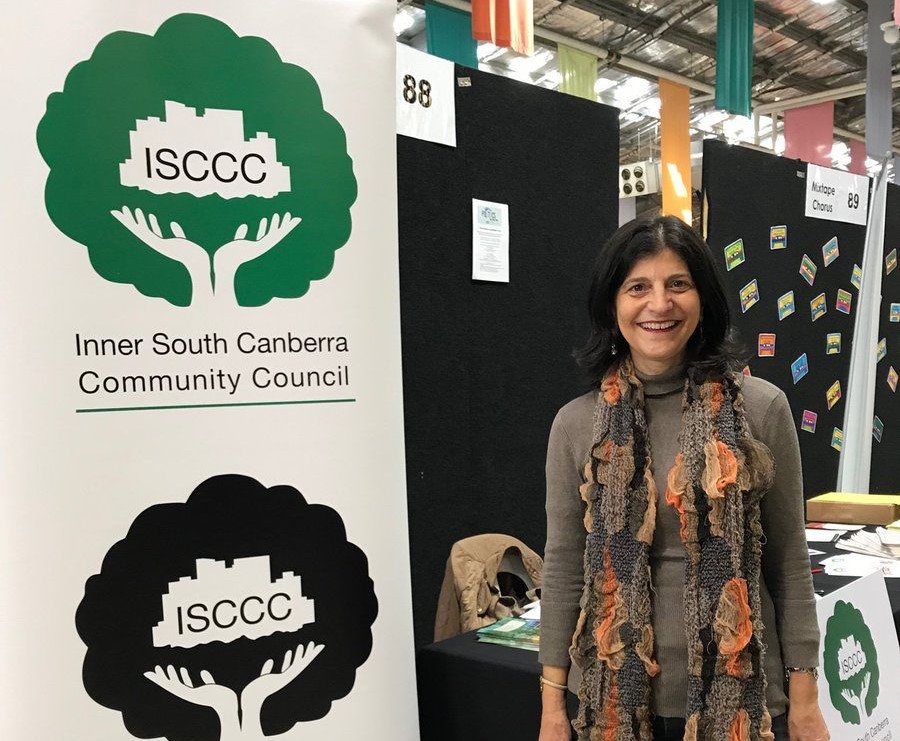
Inner South Canberra Community Council chair Marea Fatseas says the Greens need use their power if they are serious about sustainability. Photo: ISCCC.
The ACT Greens have been told to provide more than platitudes to ensure infill doesn’t rob Canberra of valuable green space.
The Inner South Canberra Community Council has thrown down the challenge to the Greens, which recently followed their Labor coalition partner in adopting an upzoning policy for the RZ1 single dwelling zone to allow two houses on a block, and higher density near shops in the RZ2 zone.
At the same time the Greens say it is imperative that infill development still allows sufficient sunlight and space on blocks for greenery.
“Central to this is also ensuring we keep good solar access for everyone and leave ample room for trees and green spaces to offset the heat island effect and give people direct access to nature,” MLAs Jo Clay and Rebecca Vassarotti said in a recent Region opinion piece.
ISCCC chair Marea Fatseas said there was a big gap between what the Greens promised and what they actually delivered.
But Ms Fatseas said the Greens held the balance of power in the Legislative Assembly and there was still time for them to show how they were going to ensure that the outcomes they said they wanted could be achieved.
“We’re not going to get the new draft Territory Plan out until the end of September,” she said.
“We want to see what they are going to do to make sure that their platitudes about this are going to be supported by actual practical rules or measures that will see us getting a good outcome.”
Ms Fatseas said that at the very least there needed to be mandatory rules for planting areas on residential blocks to allow trees and gardens, sufficient sunlight and protection of private open space from overshadowing.
She said the government seemed to be relying on design guides and technical specifications that did not have any statutory effect to enforce these measures.
The council’s own study of the development of former My Fluffy blocks in the Inner South had clearly shown a loss of green and open space, with a 15 per cent loss of planting area in Griffith and 19 per cent in Narrabundah.
Ms Fatseas said that if a volunteer group could conduct its own study, why couldn’t the government do research on what was virtually a pilot infill project to guide its planning changes.
She said the government was also yet to update its heat island mapping, last done in 2017, and was not expected to do it until the summer of 2024-25.
“They’re going ahead with the new planning system and district strategies ahead of having some important scientific information that should be guiding them in their planning,” she said.

A former Mr Fluffy in Narrabundah, before 2016 and in 2022 after dual occupancy development. Photo: ISCCC.
Kingston Barton Residents Group president and retired urban planner and architect Richard Johnston said achieving sustainable “missing middle” medium density meant building on sites big enough to allow the space needed for planting and trees.
Mr Johnston said this had been done before self-government in the Inner South and there were good examples of the results in Kingston.
He said innovative projects on larger consolidated blocks or at precinct scale would deliver significant increased housing supply but in a more environmentally responsible way than single-block development.
The government should start with areas still available for development, which in the Inner South included the Kingston Foreshore and East Lake, then look at softer options in the established areas.
Mr Johnston said controls could also be loosened on the RZ2 areas, where big knockdown rebuilds as single homes were maxing out blocks.
“It’s a bit of a joke at the moment, we’re getting huge single houses on blocks that are supposed to be available for higher density,” he said.
Developers were paying lip service to the current tree canopy and permeable space settings but the key was having a site of sufficient size to work with and clear rules.
Mr Johnston said greed appeared to be driving the whole system at present – from the government wanting to maximise its take from land sales and what was allowable on sites to developers needing to recoup their investment and building as much as they could on a block.
“It’s the rules they’re chucking away that is the problem, and the lack of trust in the development area because ultimately we’re all going to be at the mercy of arbitrary decisions made by the planning authority,” he said.





















